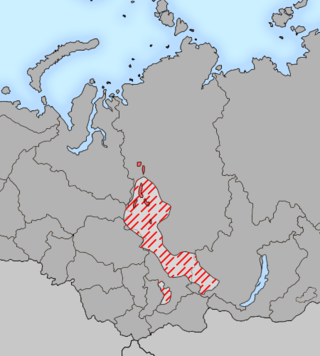
Altaic is a controversial proposed language family that would include the Turkic, Mongolic and Tungusic language families and possibly also the Japonic and Koreanic languages. The hypothetical language family has long been rejected by most comparative linguists, although it continues to be supported by a small but stable scholarly minority. Speakers of the constituent languages are currently scattered over most of Asia north of 35° N and in some eastern parts of Europe, extending in longitude from the Balkan Peninsula to Japan. The group is named after the Altai mountain range in the center of Asia.

Sino-Tibetan, also cited as Trans-Himalayan in a few sources, is a family of more than 400 languages, second only to Indo-European in number of native speakers. The vast majority of these are the 1.3 billion native speakers of Sinitic languages. Other Sino-Tibetan languages with large numbers of speakers include Burmese and the Tibetic languages. Other languages of the family are spoken in the Himalayas, the Southeast Asian Massif, and the eastern edge of the Tibetan Plateau. Most of these have small speech communities in remote mountain areas, and as such are poorly documented.

The Northwest Caucasian languages, also called West Caucasian, Abkhazo-Adyghean, Abkhazo-Circassian, Circassic, or sometimes Pontic languages, is a family of languages spoken in the northwestern Caucasus region, chiefly in three Russian republics, the disputed territory of Abkhazia, Georgia, and Turkey, with smaller communities scattered throughout the Middle East.

Burushaski is a language isolate, spoken by the Burusho people, who predominantly reside in the northern Gilgit-Baltistan, Pakistan. There are also a few hundred speakers of this language in the northern Jammu and Kashmir, India. In Pakistan, Burushaski is spoken by people in the Hunza District, the Nagar District, the northern Gilgit District, the Yasin Valley in the Gupis-Yasin District and the Ishkoman Valley of the northern Ghizer District. Their native region is located in northern Gilgit–Baltistan. It also borders with the Pamir corridor to the north. In India, Burushaski is spoken in Botraj Mohalla of the Hari Parbat region in Srinagar. It is generally believed that the language was spoken in a much wider area in the past. Other names for the language are Biltum, Khajuna, Kunjut, Brushaski, Burucaki, Burucaski, Burushaki, Burushki, Brugaski, Brushas, Werchikwar and Miśa:ski.
The Paleo-Siberian languages are several language isolates and small language families spoken in parts of Siberia. They are not known to have any genetic relationship to each other; their only common link is that they are held to have antedated the more dominant languages, particularly Tungusic and latterly Turkic languages, that have largely displaced them. Even more recently, Turkic and especially Tungusic have been displaced in their turn by Russian.

Na-Dene is a family of Native American languages that includes at least the Athabaskan languages, Eyak, and Tlingit languages. Haida was formerly included, but is now considered doubtful. By far the most widely spoken Na-Dene language today is Navajo.

The Yeniseian languages are a family of languages that are spoken by the Yeniseian people in the Yenisei River region of central Siberia. As part of the proposed Dené–Yeniseian language family, the Yeniseian languages have been argued to be part of "the first demonstration of a genealogical link between Old World and New World language families that meets the standards of traditional comparative-historical linguistics". The only surviving language of the group today is Ket.

The Austric languages are a proposed language family that includes the Austronesian languages spoken in Taiwan, Maritime Southeast Asia, the Pacific Islands, and Madagascar, as well as Kra–Dai and Austroasiatic languages spoken in Mainland Southeast Asia and South Asia. A genetic relationship between these language families is seen as plausible by some scholars, but remains unproven.

Merritt Ruhlen was an American linguist who worked on the classification of languages and what this reveals about the origin and evolution of modern humans. Amongst other linguists, Ruhlen's work was recognized as standing outside the mainstream of comparative-historical linguistics. He was the principal advocate and defender of Joseph Greenberg's approach to language classification.

Dené–Caucasian is a proposed language family that includes widely-separated language groups spoken in the Northern Hemisphere: Sino-Tibetan languages, Yeniseian languages, Burushaski and North Caucasian languages in Asia; Na-Dené languages in North America; and the Vasconic languages from Europe.

Sergei Anatolyevich Starostin was a Russian historical linguist and philologist, perhaps best known for his reconstructions of hypothetical proto-languages, including his work on the controversial Altaic theory, the formulation of the Dené–Caucasian hypothesis, and the proposal of a Borean language of still earlier date. None of his proposed macrofamilies have seen wide-scale acceptance in the linguistic community, though his proposals remain influential outside of academia. He was also the author of a widely respected reconstruction of Old Chinese.

Uralo-Siberian is a hypothetical language family consisting of Uralic, Yukaghir, and Eskaleut. It was proposed in 1998 by Michael Fortescue, an expert in Eskaleut and Chukotko-Kamchatkan, in his book Language Relations across Bering Strait. Some have attempted to include Nivkh in Uralo-Siberian. Until 2011, it also included Chukotko-Kamchatkan. However, after 2011 Fortescue only included Uralic, Yukaghir and Eskaleut in the theory, although he argued that Uralo-Siberian languages have influenced Chukotko-Kamchatkan. It is considered a fringe theory by linguists.
John D. Bengtson is an American historical and anthropological linguist. He is past president and currently vice-president of the Association for the Study of Language in Prehistory, and has served as editor of the journal Mother Tongue. Since 2001 he has been a member/researcher of Evolution of Human Languages, an international project on the linguistic prehistory of humanity coordinated by the Santa Fe Institute. His areas of specialization include Scandinavian languages and linguistics, Indo-European linguistics, Dené–Caucasian (Sino-Caucasian) languages, and paleolinguistics.

Borean is a hypothetical linguistic macrofamily that encompasses almost all language families worldwide except those native to the Americas, Africa, Oceania, and the Andaman Islands. Its supporters propose that the various languages spoken in Eurasia and adjacent regions have a genealogical relationship, and ultimately descend from languages spoken during the Upper Paleolithic in the millennia following the Last Glacial Maximum. The name Borean is based on the Greek βορέας, and means "northern". This reflects the fact that the group is held to include most language families native to the northern hemisphere. Two distinct models of Borean exist: that of Harold C. Fleming and that of Sergei Starostin.
Paleolinguistics is a term used by some linguists for the study of the distant human past by linguistic means. For most historical linguists there is no separate field of paleolinguistics. Those who use the term are generally advocates of hypotheses not generally accepted by mainstream historical linguists, a group colloquially referred to as "long-rangers".

Georgiy Sergeevich "George" Starostin is a Russian linguist. He is the son of the late historical linguist Sergei Starostin (1953–2005), and his work largely continues his father's. He is also known as a self-published music reviewer, author of the Only Solitaire Blog.
Dené–Yeniseian is a proposed language family consisting of the Yeniseian languages of central Siberia and the Na-Dené languages of northwestern North America.
There have been various classification schemes for Southeast Asian languages.
Proto-Yeniseian or Proto-Yeniseic is the unattested reconstructed proto-language from which all Yeniseian languages are thought to descend from. It is uncertain whether Proto-Yeniseian had a similar tone/pitch accent system as Ket. Many studies about Proto-Yeniseian phonology have been done, however there are still many things unclear about Proto-Yeniseian. The probable location of the Yeniseian homeland is proposed on the basis of geographic names and genetic studies, which suggests a homeland in Southern Siberia.













